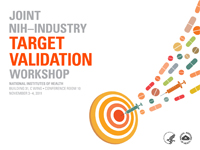Identifying and Validating Drug Targets
Thanks in large part to the Human Genome Project and the dramatic decreases in the cost of DNA sequencing, scientists can sort through the roughly 35,000 genes in the human genome to identify sites associated with disease. Discoveries of the molecular basis of diseases point to exciting potential pathways for developing safe and effective treatments.
Most drugs block the action of a particular target protein or cell structure. The only way to be completely certain that a protein is instrumental in a given disease is to test the idea in humans. Obviously, human clinical trials cannot be used in the early phases of drug development; therefore, a potential target protein must undergo a validation process (i.e., the role of the protein in that disease must be clearly defined before looking for drugs that act against it or before it is used to screen large numbers of compounds for drug activity).
Finding the Needle in a Haystack
Not so long ago, potential drug targets were hard to come by; now the pharmaceutical industry is deluged with them. Researchers must sift through reams of data in search of proteins that are instrumental in human disease. “There are too many potential leads to take them on one at a time,” according to NIH Director Dr. Francis Collins. “Therefore, we want to filter or prioritize based on the likelihood of a target’s leading to promising therapeutics.”
New methods, approaches, tools and technologies are needed to validate targets in a more efficient and predictable fashion, thereby ensuring that the drug development path leads to safe and effective products.
NCATS Steps Up to the Challenge

A joint NIH-Industry workshop titled “Target Selection and Validation in the Genomic Era: The Need for New Strategies” was held in November 2011 with participants representing pharmaceutical companies, academic centers, and the federal government. The workshop focused on the important roles of target validation at various points in preclinical drug development:
- Causality: Is the pathway likely to be causal in disease?
- Safety: Can human genetics provide early indications of important safety and efficacy signals?
- Mechanism: What are the likely mechanisms behind the associations of specific genes with specific diseases?
- Risk reversibility: Is the strength of any association enough to warrant a randomized clinical trial?
- Precision: Are there particular patient populations that are at greater risk of developing a disease and would especially benefit from a targeted therapy?
- Molecular pharmacology: How can the protein pathway be efficiently modified by a drug to reverse disease?
NCATS' Office of the Director is undertaking a target validation initiative to develop a more strategic, harmonized and streamlined approach that incorporates new genetic and phenotypic (gene expression) information.
Specifically, NCATS is supporting efforts to:
- Develop strategic tools and methods for a more harmonized approach to target validation.
- Identify drug targets faster and more efficiently.
- Provide a precompetitive collaborative environment for validation efforts.
In FY 2013, NCATS will collaborate with industry to develop a consortium capable of providing a repository and an analytic platform for target validation efforts. Establishing a precompetitive consortium could pave the way for fruitful collaboration among academia, industry and NIH.
NCATS also supports pilot projects focused on discovering better approaches to validating potential new targets.

NCATS’ Kalypsys robot enables ultra-high throughput screening of small molecules against diverse types of assays.
Social Media Links